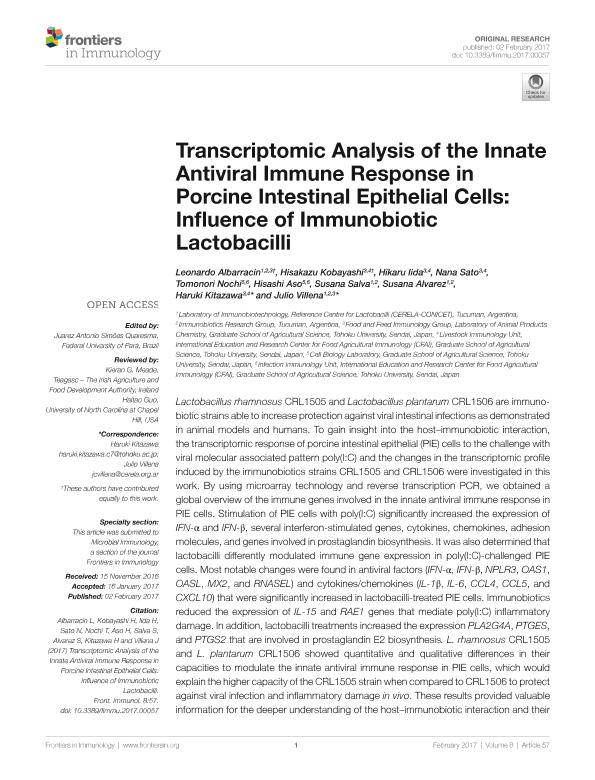Mostrar el registro sencillo del ítem
dc.contributor.author
Albarracín, Leonardo Miguel

dc.contributor.author
Kobayashi, Hisakazu
dc.contributor.author
Iida, Hikaru
dc.contributor.author
Sato, Nana
dc.contributor.author
Nochi, Tomonori
dc.contributor.author
Aso, Hisashi
dc.contributor.author
Salva, Maria Susana

dc.contributor.author
Alvarez, Gladis Susana

dc.contributor.author
Kitazawa, Haruki
dc.contributor.author
Villena, Julio Cesar

dc.date.available
2018-03-02T21:14:11Z
dc.date.issued
2017-02
dc.identifier.citation
Albarracín, Leonardo Miguel; Kobayashi, Hisakazu; Iida, Hikaru; Sato, Nana; Nochi, Tomonori; et al.; Transcriptomic Analysis of the Innate Antiviral Immune Response in Porcine Intestinal Epithelial Cells: Influence of Immunobiotic Lactobacilli; Frontiers; Frontiers in Immunology; 8; FEB; 2-2017; 1-15
dc.identifier.issn
1664-3224
dc.identifier.uri
http://hdl.handle.net/11336/37769
dc.description.abstract
Lactobacillus rhamnosus CRL1505 and Lactobacillus plantarum CRL1506 are immunobiotic strains able to increase protection against viral intestinal infections as demonstrated in animal models and humans. To gain insight into the host-immunobiotic interaction, the transcriptomic response of porcine intestinal epithelial (PIE) cells to the challenge with viral molecular associated pattern poly(I:C) and the changes in the transcriptomic profile induced by the immunobiotics strains CRL1505 and CRL1506 were investigated in this work. By using microarray technology and reverse transcription PCR, we obtained a global overview of the immune genes involved in the innate antiviral immune response in PIE cells. Stimulation of PIE cells with poly(I:C) significantly increased the expression of IFN-α and IFN-β, several interferon-stimulated genes, cytokines, chemokines, adhesion molecules, and genes involved in prostaglandin biosynthesis. It was also determined that lactobacilli differently modulated immune gene expression in poly(I:C)-challenged PIE cells. Most notable changes were found in antiviral factors (IFN-α, IFN-β, NPLR3, OAS1, OASL, MX2, and RNASEL) and cytokines/chemokines (IL-1β, IL-6, CCL4, CCL5, and CXCL10) that were significantly increased in lactobacilli-treated PIE cells. Immunobiotics reduced the expression of IL-15 and RAE1 genes that mediate poly(I:C) inflammatory damage. In addition, lactobacilli treatments increased the expression PLA2G4A, PTGES, and PTGS2 that are involved in prostaglandin E2 biosynthesis. L. rhamnosus CRL1505 and L. plantarum CRL1506 showed quantitative and qualitative differences in their capacities to modulate the innate antiviral immune response in PIE cells, which would explain the higher capacity of the CRL1505 strain when compared to CRL1506 to protect against viral infection and inflammatory damage in vivo. These results provided valuable information for the deeper understanding of the host-immunobiotic interaction and their effect on antiviral immunity. The comprehensive transcriptomic analyses successfully identified a group of genes (IFN-β, RIG1, RNASEL, MX2, A20, IL27, CXCL5, CCL4, PTGES, and PTGER4), which can be used as prospective biomarkers for the screening of new antiviral immunobiotics in PIE cells and for the development of novel functional food and feeds, which may help to prevent viral infections.
dc.format
application/pdf
dc.language.iso
eng
dc.publisher
Frontiers

dc.rights
info:eu-repo/semantics/openAccess
dc.rights.uri
https://creativecommons.org/licenses/by-nc-sa/2.5/ar/
dc.subject
Antiviral Response
dc.subject
Immunotranscriptomic Response
dc.subject
Intestinal Epithelial Cells
dc.subject
Lactobacillus Plantarum Crl1506
dc.subject
Lactobacillus Rhamnosus Crl1505
dc.subject
Tlr3
dc.subject.classification
Inmunología

dc.subject.classification
Medicina Básica

dc.subject.classification
CIENCIAS MÉDICAS Y DE LA SALUD

dc.title
Transcriptomic Analysis of the Innate Antiviral Immune Response in Porcine Intestinal Epithelial Cells: Influence of Immunobiotic Lactobacilli
dc.type
info:eu-repo/semantics/article
dc.type
info:ar-repo/semantics/artículo
dc.type
info:eu-repo/semantics/publishedVersion
dc.date.updated
2017-12-04T18:22:44Z
dc.journal.volume
8
dc.journal.number
FEB
dc.journal.pagination
1-15
dc.journal.pais
Estados Unidos

dc.description.fil
Fil: Albarracín, Leonardo Miguel. Consejo Nacional de Investigaciones Científicas y Técnicas. Centro Científico Tecnológico Conicet - Tucuman. Centro de Referencia Para Lactobacilos; Argentina. Tohoku University; Japón
dc.description.fil
Fil: Kobayashi, Hisakazu. Tohoku University; Japón
dc.description.fil
Fil: Iida, Hikaru. Tohoku University; Japón
dc.description.fil
Fil: Sato, Nana. Tohoku University; Japón
dc.description.fil
Fil: Nochi, Tomonori. Tohoku University; Japón
dc.description.fil
Fil: Aso, Hisashi. Tohoku University; Japón
dc.description.fil
Fil: Salva, Maria Susana. Consejo Nacional de Investigaciones Científicas y Técnicas. Centro Científico Tecnológico Conicet - Tucuman. Centro de Referencia Para Lactobacilos; Argentina
dc.description.fil
Fil: Alvarez, Gladis Susana. Consejo Nacional de Investigaciones Científicas y Técnicas. Centro Científico Tecnológico Conicet - Tucuman. Centro de Referencia Para Lactobacilos; Argentina
dc.description.fil
Fil: Kitazawa, Haruki. Tohoku University; Japón
dc.description.fil
Fil: Villena, Julio Cesar. Consejo Nacional de Investigaciones Científicas y Técnicas. Centro Científico Tecnológico Conicet - Tucuman. Centro de Referencia Para Lactobacilos; Argentina
dc.journal.title
Frontiers in Immunology
dc.relation.alternativeid
info:eu-repo/semantics/altIdentifier/doi/http://dx.doi.org/10.3389/fimmu.2017.00057
dc.relation.alternativeid
info:eu-repo/semantics/altIdentifier/url/https://www.frontiersin.org/articles/10.3389/fimmu.2017.00057/full
Archivos asociados
